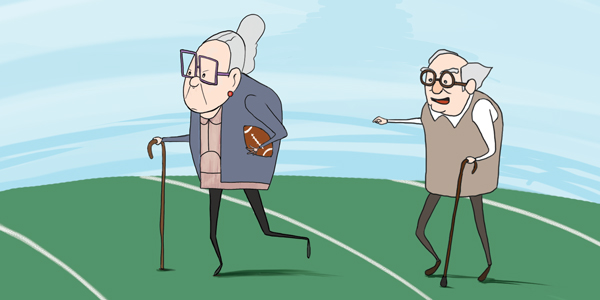Aging athletes more prone to injuries

Former collegiate athletes may suffer from health limitations later in life
March 31, 2014
Collegiate athletes are more likely to face health issues in their day-to-day lives as they age, according to new research from Indiana University.
The research, published March 2014 in the American Journal of Sports Medicine studied former NCAA Division 1 athletes and recreationally active non-athletes ages 40–60. They found D1 athletes were twice as likely to have health limitations such as muscle and bone damage as non-athletes.
More than two-thirds of former collegiate athletes also reported chronic or major injuries compared to 26–28 percent of non-athletes, according to the study.
“Just being an athlete in general puts more wear and tear on your body,” said Sara Brown, doctor of osteopathic medicine at Chicago Primary Care Sports Medicine. “It will increase your chances of arthritis and injuries like that just because of the simple fact that you’re putting more miles on your body just like if you put more miles on your car.”
According to the results, 40 percent of D1 athletes reported having been diagnosed with osteoarthritis, or degeneration of joint cartilage, after college. The condition is linked to previous joint injuries that the athlete may have suffered during college, said David Geier, orthopedic surgeon and sports medicine specialist in Charleston, N.C.
The study also indicates that former athletes experience depression, fatigue and disrupted sleep patterns.
“Playing sports in and of itself is not necessarily harmful,” Geier said. “But if you suffer injuries like ACL tears, meniscus tears, that kind of thing, there’s a risk for long-term arthritis and other problems.”
The study notes that D1 athletes have a range of expertise and coaching at their disposal when they are in college but are left to organize their own exercise plans after graduation. Players therefore are unable to maintain health and effective practice regimens, causing injuries and long-term damage.
Patricia Kaufman, director of operations at Chicago Chiropractic and Sports Medicine, said some former college athletes she sees at the training clinic are trying to reestablish a healthy and active lifestyle years after college sports.
“You do lose muscle mass and get more injuries because your mobility and your agility decrease as you age,” Kaufman said.
Working on balance and core strength and being physically active can help prevent future injuries, Brown said.
Geier said if athletes are experiencing pain from an injury, they should see an athletic trainer or team doctor for early treatment to avoid more serious injuries later in life.
“I think the main part for college athletes is that when you’re having a problem or when you’re having pain, don’t ignore it or deny it just to stay in the game,” Geier said.
Geier said the study results serve as a cautionary tale but should not deter talented athletes from competing in collegiate athletics.
“It would be unfair to say just because you play sports you’re going to develop worse problems,” Geier said. “It’s just that if you suffer an injury playing sports, you’re more likely than someone who hasn’t suffered those similar injuries.”







